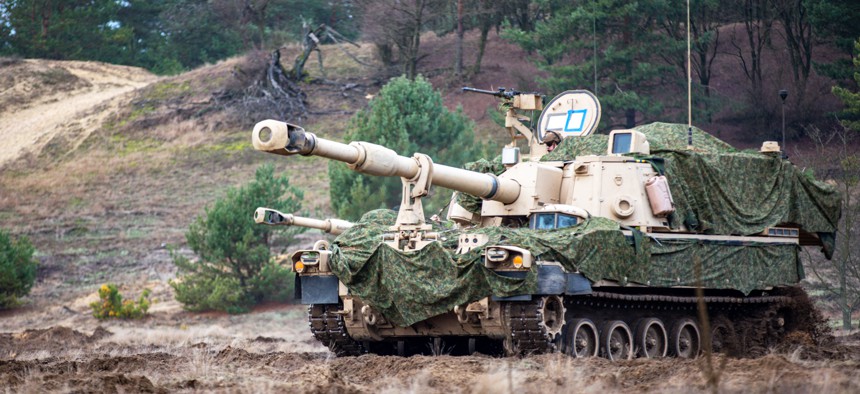
Soldiers assigned to the 2nd Platoon, Bull Battery, 1st Battalion, 7th Field Artillery Regiment, 2nd Armored Brigade Combat Team, 1st Infantry Division, maneuver a M109A7 Paladin howitzer into position during a live-fire exercise at Toruń, Poland, Jan. 17, 2023. Army National Guard / Army Staff Sgt. Matthew Foster
As US Rushed Troops to Europe, Logistics Staff Faced Problems Supplying Them With Weapons
U.S. logisticians beat the clock to supply equipment for a snap deployment, but soldiers reported maintenance issues with vehicles and missing equipment.
As Russian troops pressed into Ukraine in February 2022, U.S. logistics crews in Germany were hustling to do something unprecedented: pull enough arms, vehicles, and other supplies from prepositioned storage to outfit an entire Army brigade combat team that was being rushed from its stateside base to Europe. They pulled it off faster than anyone thought possible—but with hiccups that provide lessons for future deployments, the Defense Department’s inspector general found.
More than 10 percent of the material issued in Germany to the 1st Armored Brigade Combat Team, or ABCT, was less than fully ready for use, forcing costly cannibalization and paperwork, according to a Feb. 27 report by the IG.
Still, the Army’s 405th Army Field Support Brigade delivered the gear in just half the time expected, drawing kudos from Army Chief of Staff Gen. James McConville. The service’s Sustainment Command, including the 405th, had brought the Army to “an incredible level of readiness,” he said on March 8, 2022.
The problem of supplying U.S. forces in Europe has gained importance since the Russian invasion. The U.S. positions military equipment in Europe so that troops coming from the United States don’t have to waste time transferring material. The program is particularly helpful for units with heavy equipment. The 1st ABCT equipment includes heavy vehicles such as the M1 Abrams tank, Bradley fighting vehicles, Paladin self-propelled artillery, and support vehicles such as the M88 recovery vehicle, used for towing damaged tanks off the battlefield.
The prepositioned stocks are “essential” to defending Europe, said Elvira Loredo, an associate program director at the RAND Corporation, amid a drawdown of U.S. troop numbers in Europe since the end of the Cold War. Troop levels in Germany, the hub of U.S. forces in Europe, declined from over 248,000 in 1989 to fewer than 36,000 in 2021.
The 405th Brigade began communicating with the 1st ABCT in mid-December to coordinate equipment transfers from storage in Mannheim and Dulmen.
Logistics units had never before issued equipment to a full brigade combat team. The 405th estimated they would need 75 days, but managed to deliver the equipment 39 days ahead of schedule, the inspector general report said, citing 405th Army Field Support Brigade commanders.
The unit used everything it could to move the equipment, including commercial trucks, German rail lines, U.S. military heavy equipment transporters, and German military trucks, according to the report.
The prepositioned stocks allowed the unit to deploy mostly with individual soldier equipment and a small number of vehicles, a 3rd Infantry Division spokesperson told Defense One.
What the unit received, though, was not always up to snuff. Issued equipment had operational-readiness rates below 90 percent, according the Inspector General report, which cited vehicle maintenance as a key issue.
Some equipment was functioning but lacked important components. More than 60 percent of M88 recovery vehicles were missing secondary equipment, which forced 1ABCT to cannibalize “multiple other M88 vehicles to create working M88s,” the report said.
Other problems cropped up as well. Much of the equipment was not ready for combat, the report said, citing multiple 1st ABCT officials. Making equipment combat-ready requires replacing vehicle fuel, installing batteries, and making quick-fix repairs. Vehicles were issued without certifications for hazardous cargo, as required for European roads, leading 1st ABCT to certify the vehicles at a cost of $5.8 million.
At least part of the problem, the report said, was that the vehicle storage requirements set by the U.S. Army Sustainment Command laid out generic inspection times, rather than the more rigorous inspection times based on each equipment piece’s technical manual.
Even these less-rigorous standards were physically impossible for the 405th to meet. Per the standards, the vehicles should be regularly exercised on special tracks. Neither supply center had these tracks.
Workers for the 405th were aware of the issue, with one contracting officer telling the Inspector General’s investigators that the vehicles “always” have maintenance faults, especially if not exercised for two to four years. Another 405th employee said that the basic standards laid out by the Sustainment Command did not reveal problems a more thorough inspection would find.
Mannheim will get an exercise track by 2028 as part of a $650 million upgrade, the report stated. Commanders from Supply Command, Sustainment Command, and the 405th Brigade agreed to implement the Inspector General’s recommendations for improving equipment maintenance and distribution.
A lack of data in the inspector general’s report makes it impossible to assess exactly how things went wrong, said RAND’s Loredo.
“It might have been that the equipment was not being kept at the level required by the contract,” she said. “Or the contractor did not have sufficient time or resources to prepare the equipment for issue.”
Large exercises in Europe, such as DEFENDER-Europe, would not have exposed any issues, she added, distinguishing between the many months-long planning timeline for exercises and rapid deployments.
The outcome wasn’t “too bad,” said Mark F. Cancian, a senior advisor at the Center for Strategic and International Studies, noting the speed at which the equipment was released.
Keeping such equipment at a high level of readiness is expensive, Cancian said, and Europe likely faded as a priority amid wars in Iraq and Afghanistan.
“When the Cold War ended, the idea that you would have to rapidly pull equipment out of storage in Europe just didn’t seem very likely,” he said.





